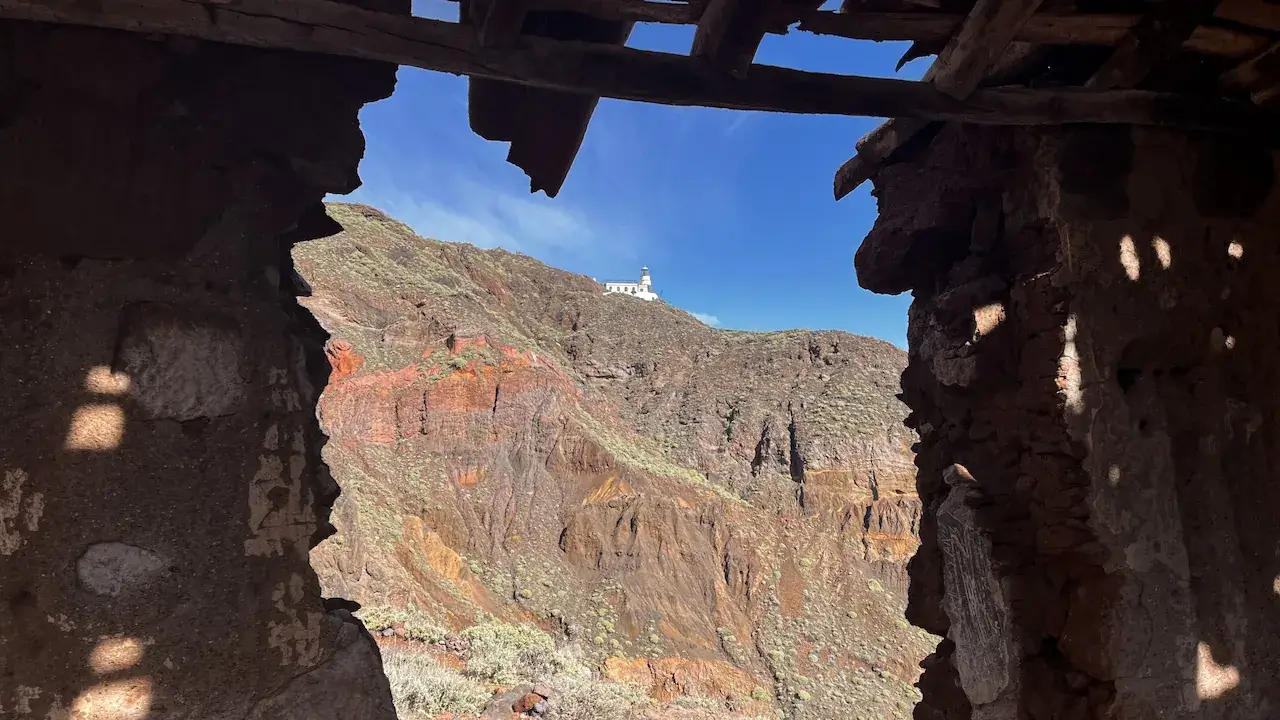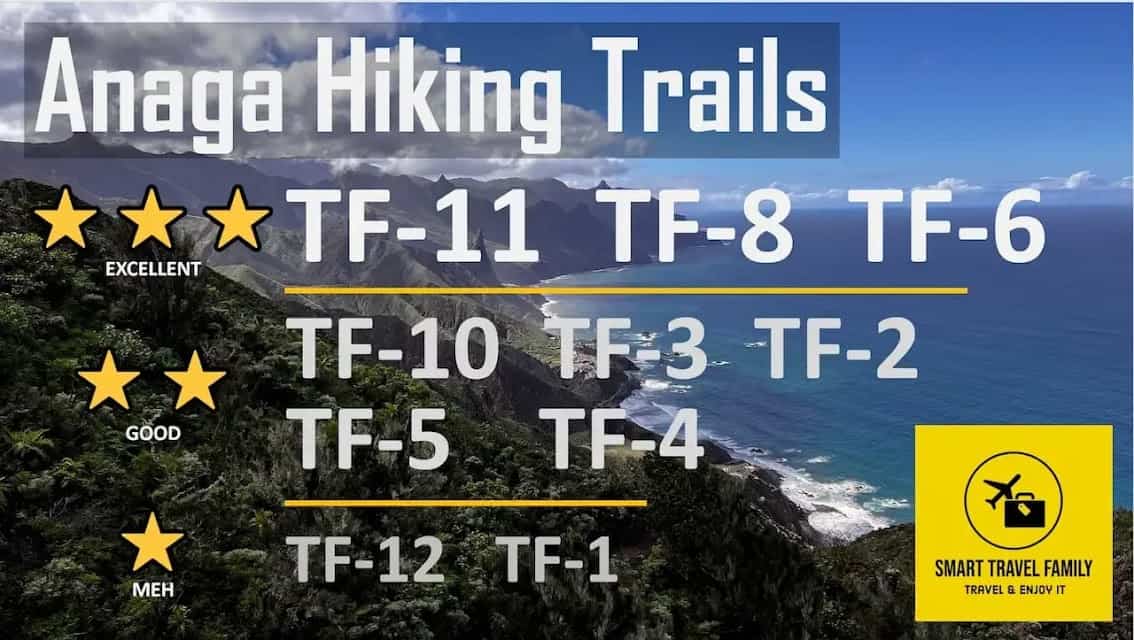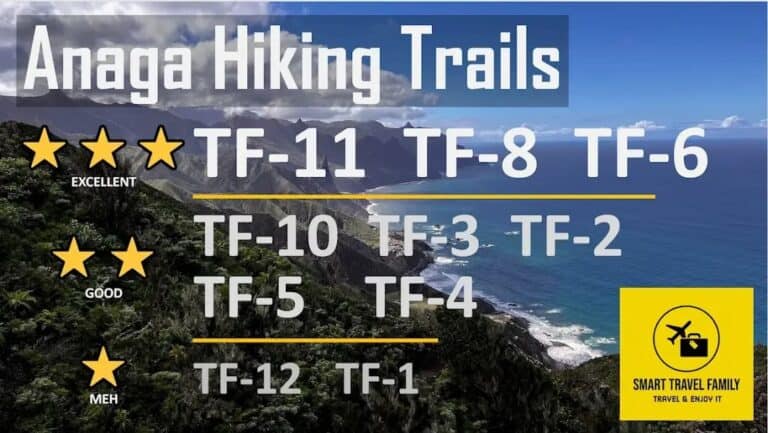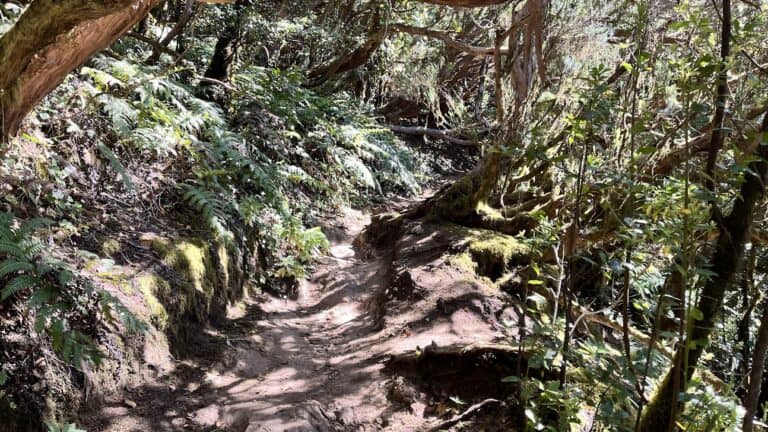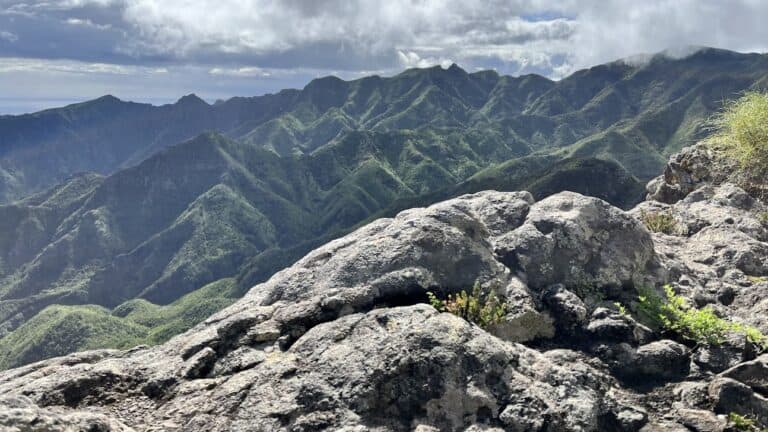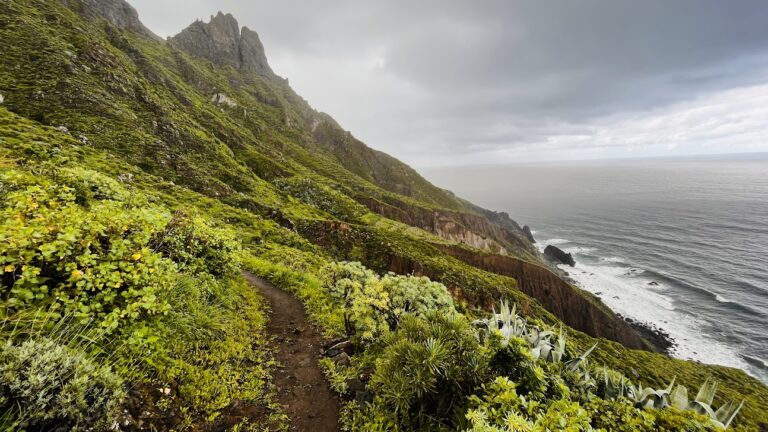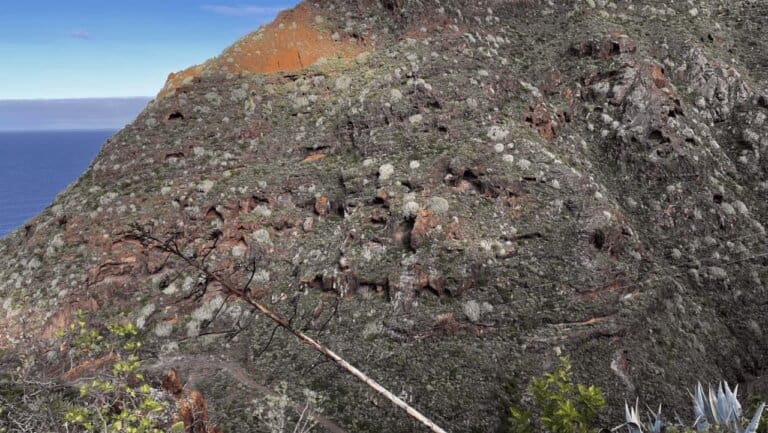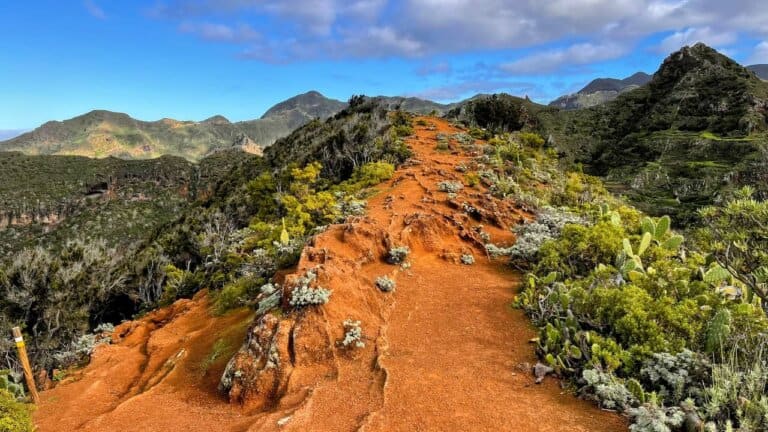TF-6 Chamorga Circular Trail Guide: Exploring Tenerife’s Northern Tip
This post may contain affiliate links. If you click one, we may earn a commission at no cost to you.
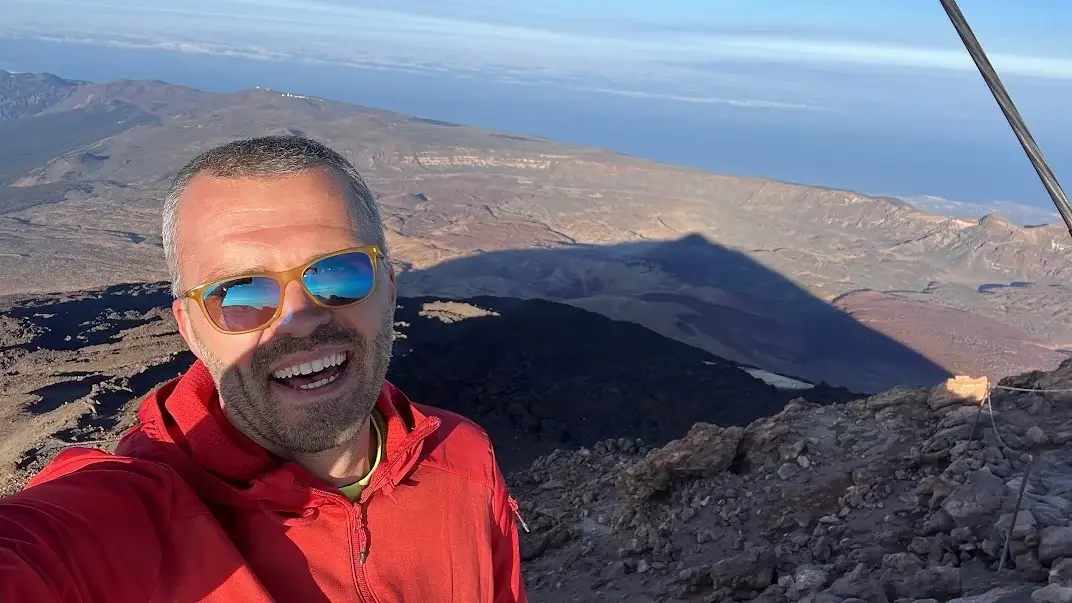
WHY TRUST THIS INFORMATION? I hiked A LOT, including a quest to hike all Anaga trails during my family’s year in Tenerife from 2022 to 2023. This and other articles are based on my personal experience, while hiking alone and with our kids.
TF-6 ‘Business Card’

The circular TF-6 trail in Anaga is one of the two iconic trails (and, hence, most popular) in this nature park, along with the TF-8. The trail starts in the most distant Anaga village of Chamorga. TF-6 is a perfect intro to everything Anaga hiking has to offer, including a superb ocean walk. Walk the extra 3 miles / 5 km to add the TF-6.2 & TF-6.3 variants through Benijo village for some additional amazing vistas.
TF-6 Ranking Among Other Anaga Hiking Trails
If you do not want to do further research, below is an overview of all Anaga hiking trails ranked from best to worst.

This ranking should be useful for the average hiker, traveling without children and not having any health issues or very low physical form.
Map of TF-6 trail with variants TF-6.1, TF-6.2 and TF-6.3
The TF-6 trail is marked in red in the above map.
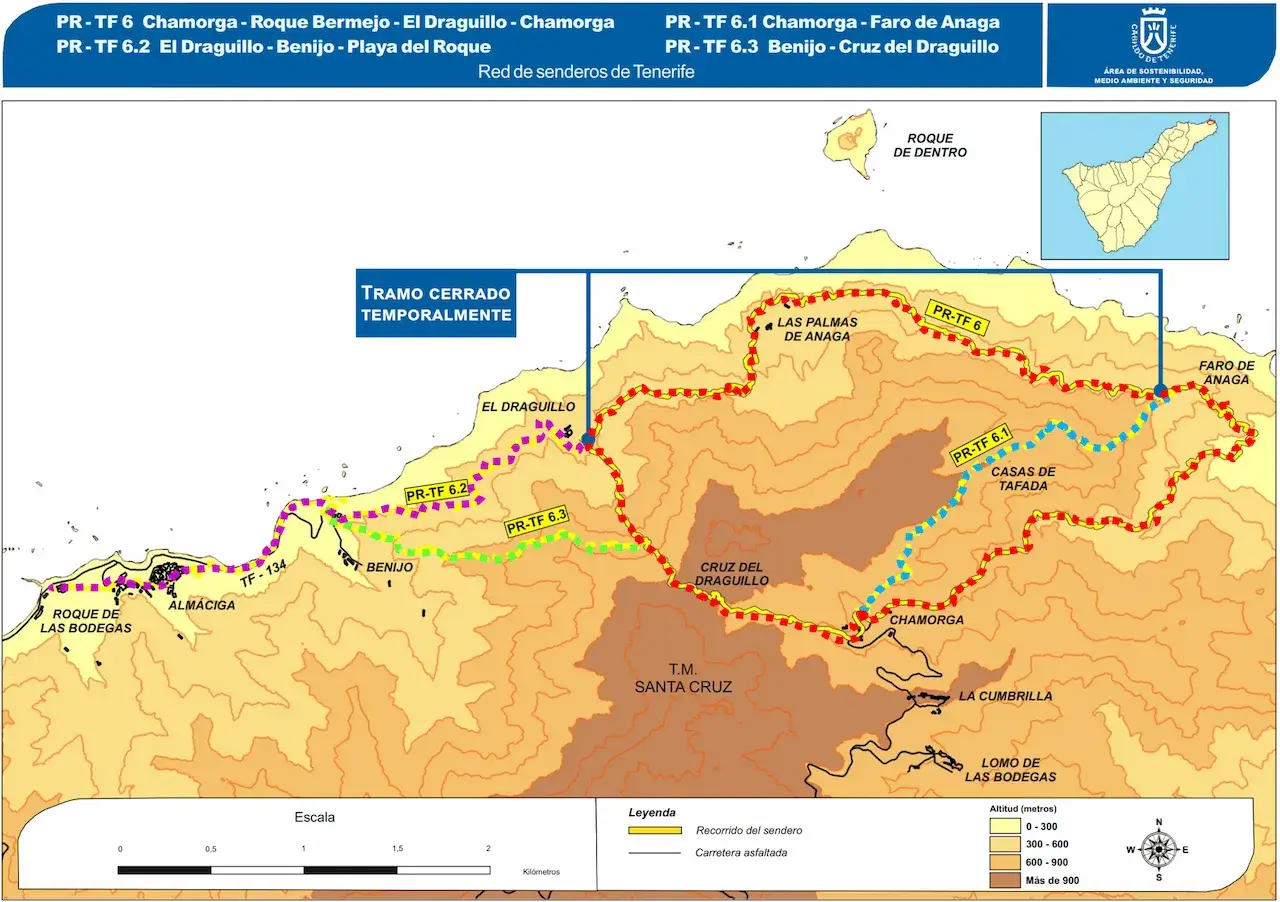
- TF-6 main Chamorga trail is marked in red on the map.
- TF-6.1 variant that goes between Chamorga village and the Anaga Lighthouse (Faro de Anaga) is marked in blue.
- TF-6.2 variant from Playa del Roque de las Bodegas to El Draguillo village (through villages of Almaciga and Benijo) is marked in violet.
- TF-6.3 variant from Benijo village towards Cruz del Draguillo is marked in green.
This is Google map of just the TF-6 with its TF-6.2 and TF-6.3 variants. The TF-6.2 variant goes closer to the ocean, and TF-6.3 is more inland. The TF-6.1 trail is not on this map as I didn’t hike it in its entirety.
The above trail length and elevation numbers are based on my GPS watch readings when doing the trail. They may differ from figures in information of the Anaga Rural Park Administration. In general, there was at least a slight discrepancy between official and hikers’ GPS readings for most Anaga trails.
Our TF-6 Hike Video
If you have any questions about this hike, please leave a comment below or under the video on YouTube, and I’ll try to respond ASAP.
Why Is the TF-6 Trail Worth Hiking?
Below is a visual introduction to the trail and its variants, however, I’ll try to summarize the main rational arguments in case amazing nature is not enough.
- TF-6 is among the top three trails in the Anaga Rural Park along with TF-8 and TF-11.
- The trail is well-balanced in the sense that if you manage to take only this trail during your stay in Tenerife, you will still get a good impression of most things the Anaga Rural Park has to offer.
- Diversity of geological phenomena.
- You get to see several villages and smaller inhabited locations, giving you an insight into the island’s past and current life.
- The ocean walk between Faro de Anaga and the El Draguillo village will give you not only stunning ocean views, but also an unobstructed view of the wild and lush Macizo de Anaga mountains.
- Adding the TF-6.2 and TF-6.3 is a “nice-to-have” (but not a must).
- Bragging rights about having done the most Northern and remote trail in Anaga.
Starting Points
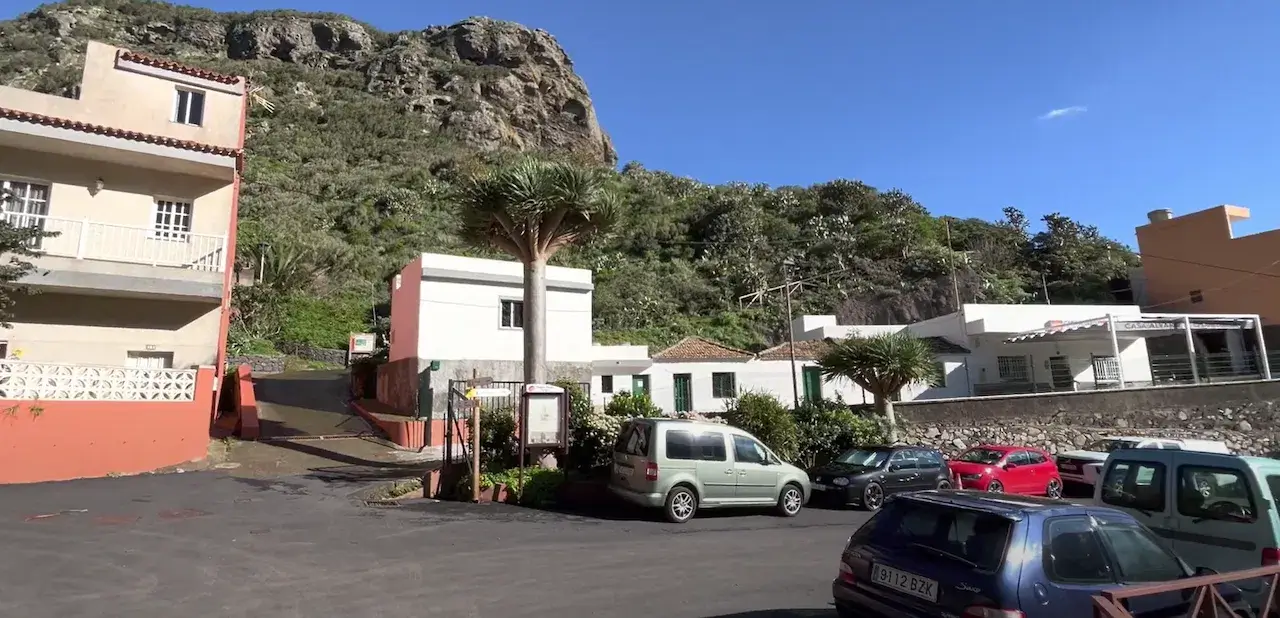
You can theoroetically start the route in four locations, as these are accesible by car: Chamorga, Benijo, El Draguillo and Roque de las Bodegas beach, however, only Chamorga and Benijo village are practical starting points due to ease of access and parking availability.
- Chamorga village, if you want to do just the TF-6 trail. Best place to park your car [Google Maps link].
- Benijo village if you are ready to hike more, combining the TF-6 trail with its TF-6.2 and TF-6.2 extensions. Best place to park your car is at Mirador the Playa Benijo [Google Maps link] which brings you on a steep street through the village.
Visual TF-6 Trail Guide and Key Landmarks
We suggest you start the TF-6 trail in the Chamorga village and first move in the direction of Playa del Roque de Bermejo and Faro de Anaga. The route in this direction is more scenic than the ascent to Cruz del Draguillo and you will get your scenic impressions immediately rather than slogging 1 mile / 1.5 km uphill through a forest.
Chamorga Village

The quaint Chamorga village is the terminal station of bus 947 from the Santa Cruz de Tenerife Intercambiador or Bus Terminal. The village also has a paved area at its centre where around 15 cars can park. It can get busy during peak travel periods, hence, first drive until the village centre to try to find a spot, and only then turn back and park at the first available spot. In the very worst scenario, you’ll have to go up the road back to Santa Cruz to find a sufficiently wide road side.
If you arrive by bus, double-check the bus departure times so that you get back in time, as public transport bus 947 serves Chamorga only 3-4 times a day. Don’t hesitate to ask fellow hikers for a ride if you’ve arrived past the last bus or way ahead of time.
Consider buying at least a snack or getting a simple meal at the Casa Alvares cafe. We enjoyed it there, the ladies serving the place are not very fluent in English, but very kind. The cafe has a large map of Anaga inside for any last minute checks. Best of all, they accept card payments so lack of cash is not a problem.
Descending Barranco de Chamorga
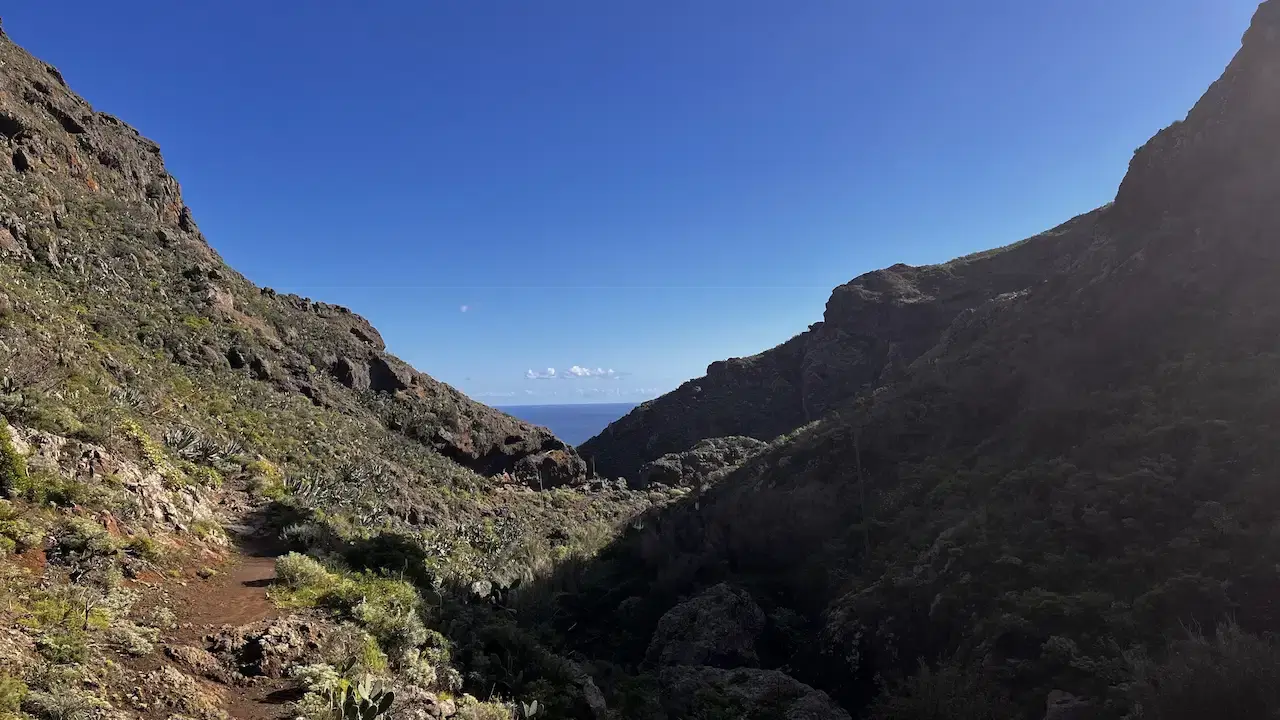
As soon as you’ll leave the Chamorga village, the barranco (a ‘ravine’ in English) will begin. While Tenerife doesn’t have any rivers, the barrancos are as close as you can get to a river on the island, as there’s water in them during the rainy season from December to February, and during heavy rains in other seasons.
The ravine barranco has nice cliffs and other geological formations on both sides as you head towards the ocean, making for a very nice down-hill walk.
Casas Blancas
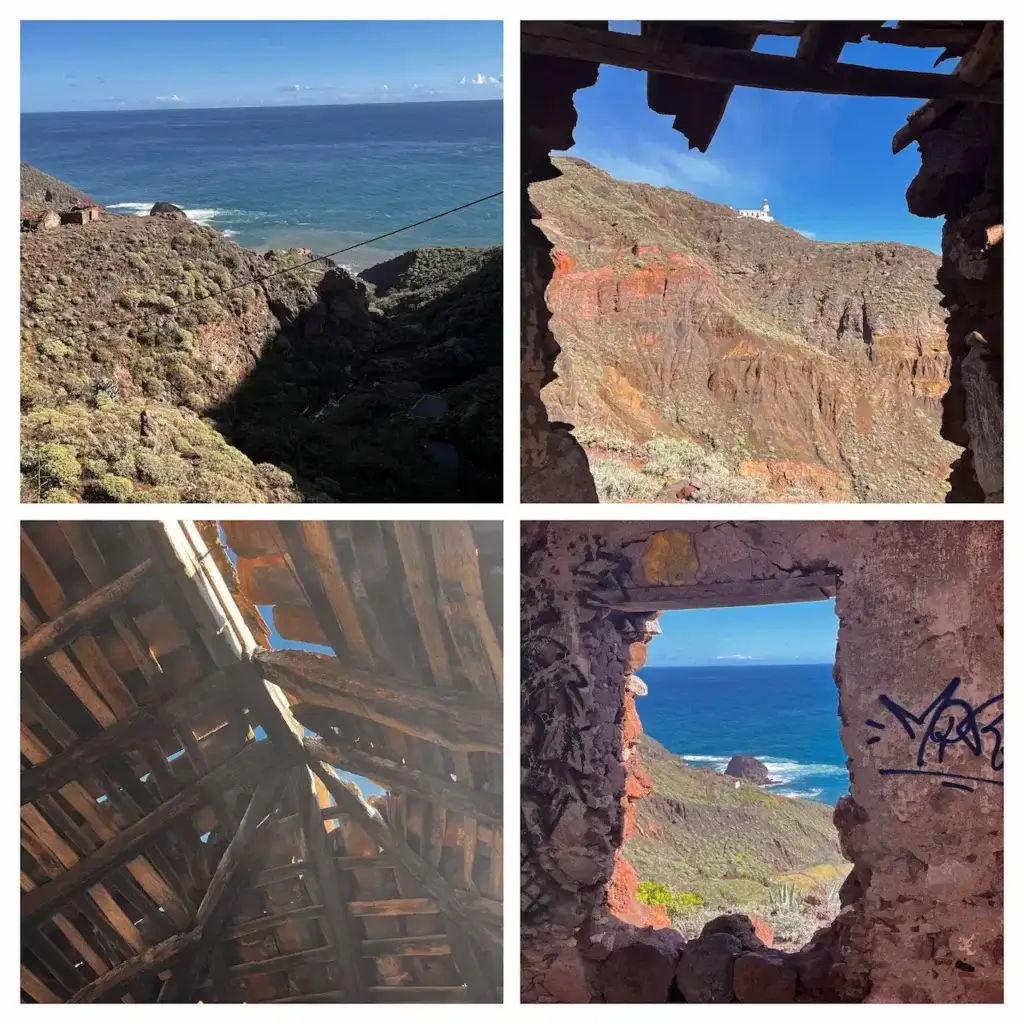
Casas Blancas is a small hamlet of abandoned houses. This tranquil spot offers superb views of the ocean, Playa de Roque Bermejo and the Anaga lighthouse up on the hill, to which you’ll have to climb to. The hamlet could once upon a time enter a conquest for the most remote inhabited location on Tenerife, but is currently beat by the 5-6 modern houses constructed right on the Playa de Roque Bermejo.
Next to the houses there’s a bench which makes for a very nice lunch, snacks or selfie break.
Playa de Roque Bermejo
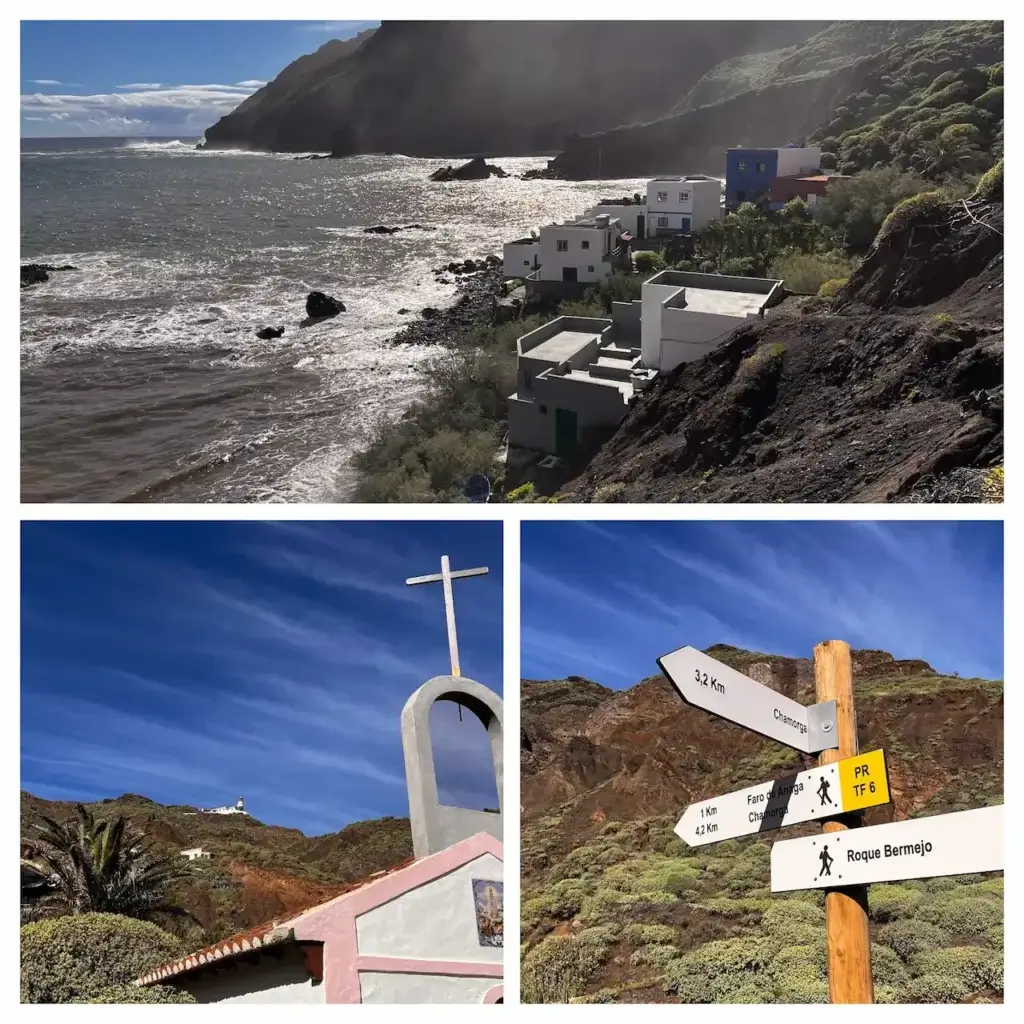
As you will descend slightly past Casas Blancas, you’ll reach a crossroads sign offering you to descend down to Playa de Roque Bermejo. Unless you are super fit or have a special interest in the beach hamlet, you can easily pass this landmark and head straight up to the Anaga Lighthouse.
In case you will head down to the beach, you’ll get to see a very tiny historic church, a recently constructed also rather tiny concrete pier, and the Roque Bermejo cliff (which is nothing to impressive by Anaga standards). Google Maps indicate that there’s a small café in the ocean coast hamlet, but it’s been closed both times I went past. The detour will add around a mile / 1.5 km to your hike and almost 100 vertical meters. For some reason, I even created a small video about the beach itself.
Faro de Anaga (Anaga Lighthouse)

After Casas Blancas and the Playa de Roque Bermejo you have the first of the two major ascents of the trail – up to the Anaga Lighthouse. Following the coastal route, we arrive at Faro de Anaga – the Anaga Lighthouse. If this will be your first hike in the Anaga, you’ll finally get to experience why a lot of hikers rave about the nature park. With every 100 vertical meters you ascend, the views get better and better.
However, the lighthouse itself seemed like nothing particularly special. There’s a constant cat and mouse game between irresponsible hikers and park administration about cutting up and fixing the fence surrounding the lighthouse. The lighthouse is officially off limits, so if there’s a hole in the fence, enter at your own risk.
Ocean walk between Faro de Anaga and El Draguillo village

Shortly after the Anaga Lighthouse you will come upon a sign warning that a section of the TF-6 trail is closed. Our experience is that in general one can safely pass the sign and continue hiking. There have been some smaller landslides in the past, and the trail is not completely restored in some sections. However, as long as one is not hiking on a rainy or very windy day, the person should be fine. Of course, proceed at your own risk and be aware that should you have an accident while taking this stretch of TF-6, it might void your insurance. This section of the path is covered from minute 7:00 in the TF-6 trail video above.
To be absolutely certain that there haven’t been any recent landslides, inquire about this question on the Tenerife Hiking Community Facebook page (link below in the Resources section).
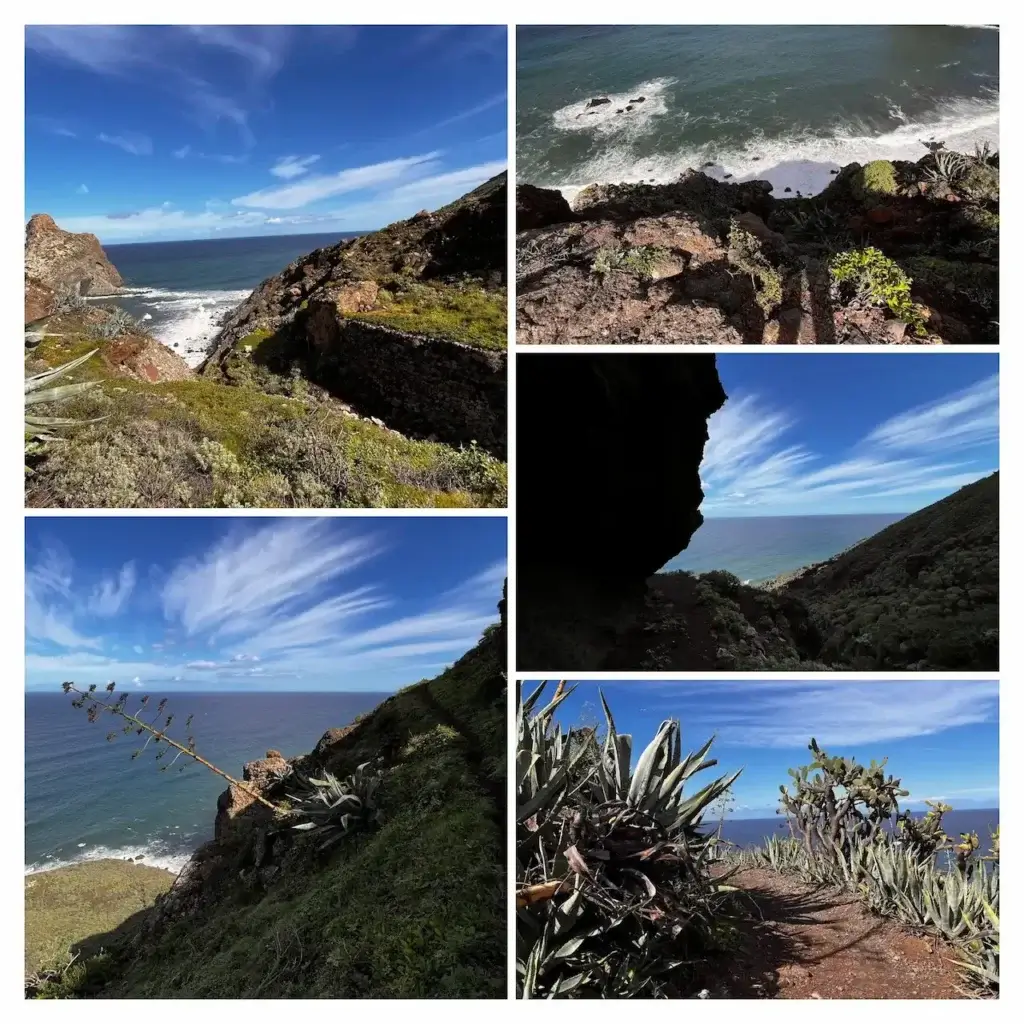
The pictures above give you some impression of the ocean walk, which goes on for about 3 miles / 5 km. However, I really suggest you also look at the video above to get the ambience. It’s really a 360 or 720 degree experience to take it all in – the lush vegetation, the ocean, and the Anaga mountains on your left as you walk towards El Draguillo village.
Las Palmas de Anaga Village
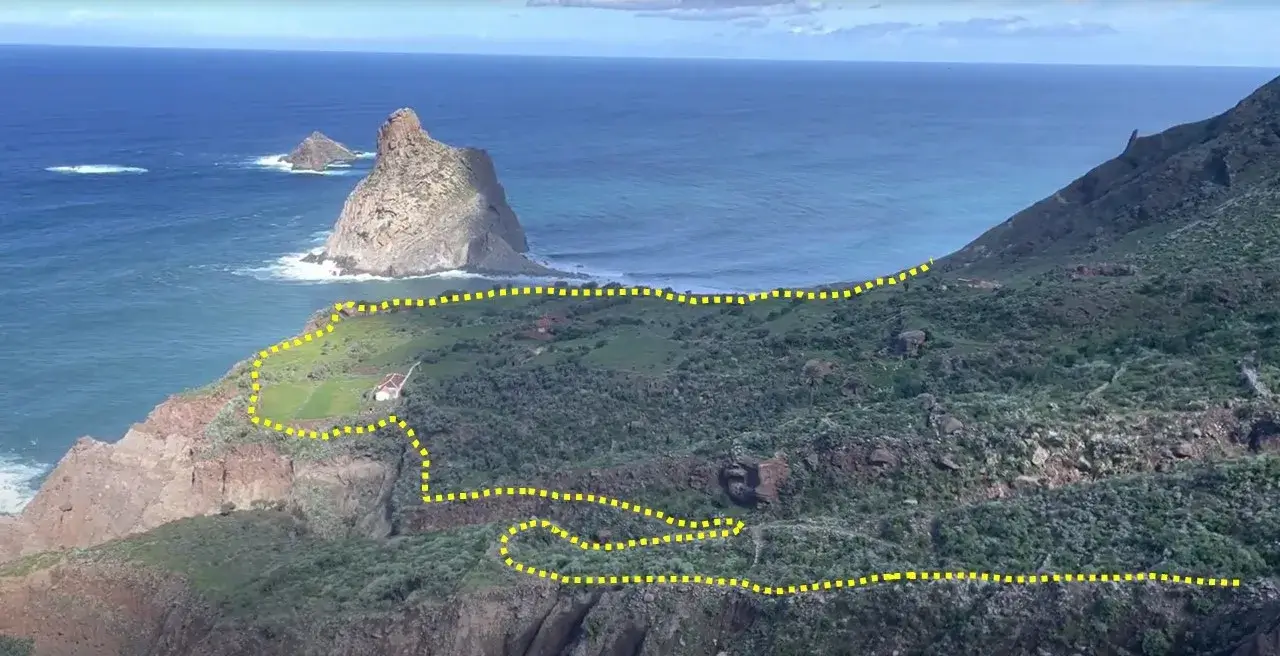
Towards the end of the ocean walk section of TF-6, you’ll reach the Las Palmas village. It is mostly abandoned, but someone appears to tend some of the gardens. I was too shy and didn’t try to enter the houses in the middle of the image, however, if you want to get some nice selfies with dragon trees among house ruins, go ahead. Just be mindful of locals and if you see someone, ask for permission first.
El Draguillo Village and the Cruz de Draguillo crossroads
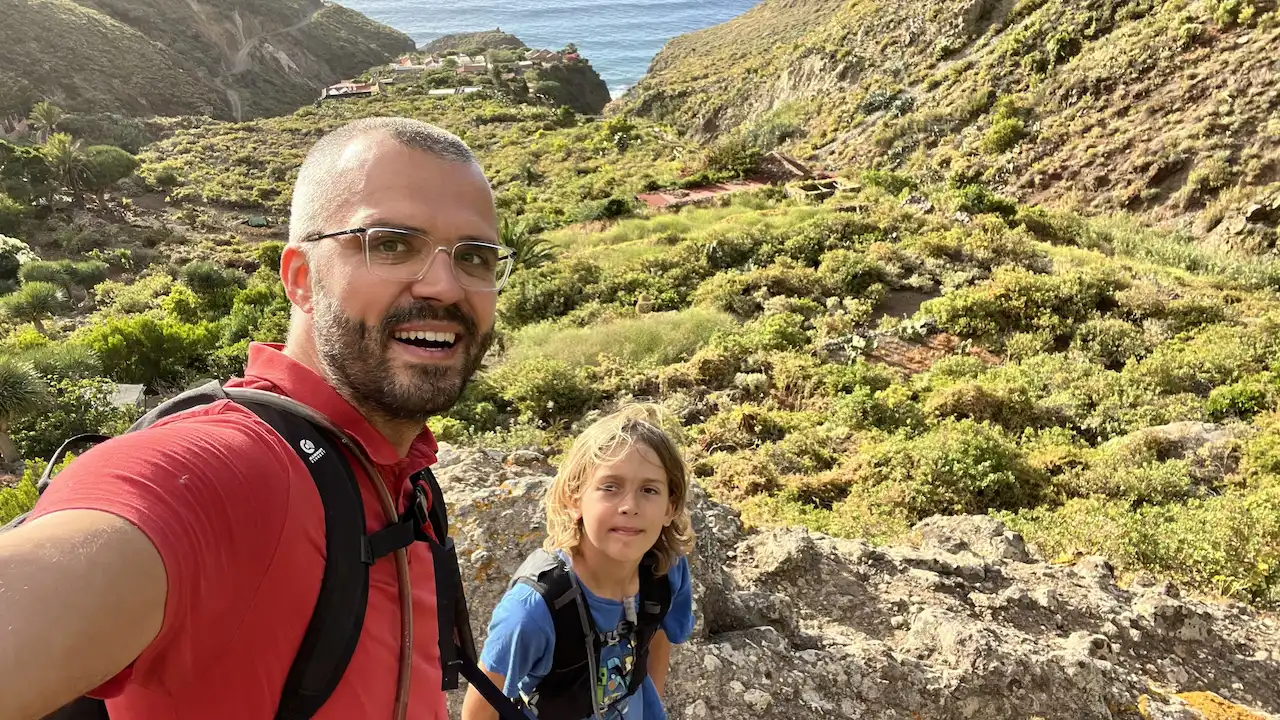
The ocean walk finishes at the El Draguillo village (or beings if you walk in the opposite direction), where your trail will take a turn to the left to return to Chamorga. The village is the location where TF-6 trail connects to TF-6.2, so you can also walk straight and continue onwards to Benijo and Almaciga villages. That are served by public transportation.
As you might have guessed, the village gets its name from the dragon trees growing in and around it, although there were no particularly large specimens.
Following El Draguillo, there’s nothing particularly scenic on the trail as you head back towards Chamorga. Also – be prepared for the second quite hard hike upwards from the village to Cruz de Draguillo, which is around 450 vertical yards / 400 vertical meters. However, you’ll be rewarded with increasingly pleasant vistas each time you take a break from ascending and turn around to have a look at the ocean.
Variants
TF-6.1 Chamorga – Faro de Anaga

You have two options to reach the Anaga Lighthouse. You can either take the original TF-6 trail through the Barranco de Chamorga, or take the TF-6.1 variant, which takes you straight over the mountain ridge, past Casas de Tafada (old house ruins). The TF-6.1 has a steep ascent, and you’ll reach the Anaga Lighthouse from the top, whereas the original TF-6 route let’s you reach the lighthouse from below. In our opinion, the TF-6 route is nicer.
Why? I found that the TF-6.1 trek past Casas de Tafada had largely the same vibe as the much of the rest of the TF-6 ocean section. Whereas the “original” TF-6 start in the barranco down to the ocean was quite different from the rest of the TF-6, with many nice volcanic formations.
However, if you are staying on the island for a longer period or are a very fit hiker, once you do the original TF-6, consider doing the unofficial variant described below that also includes most of the TF-6.1 section.
TF-6.2 and TF-6.3 variants
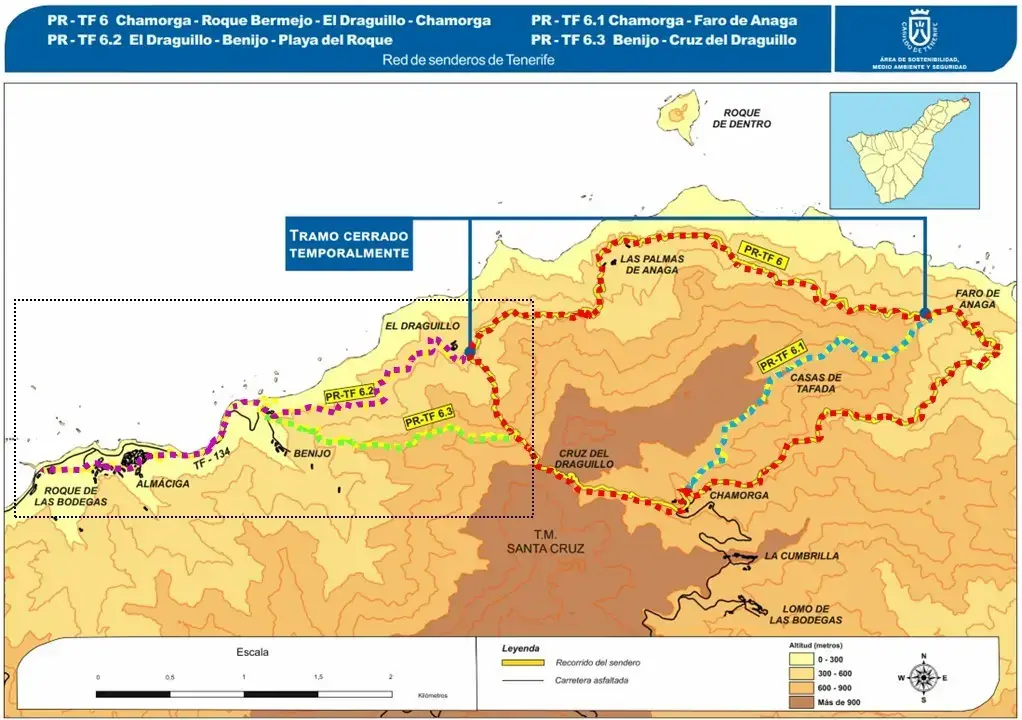
The TF-6.2 variant between Roque de Las Bodegas and El Draguillo village and the TF-6.3 variant between the Benijo village and the Cruz del Draguillo crossroads are a nice extension of the TF-6 trail, but not essential for most hikers. Experienced or physically fit hikers usually choose this addition to the TF-6 trail to make it longer, of if they have a particular reason to start out or return to the Benijo or Almaciga villages.
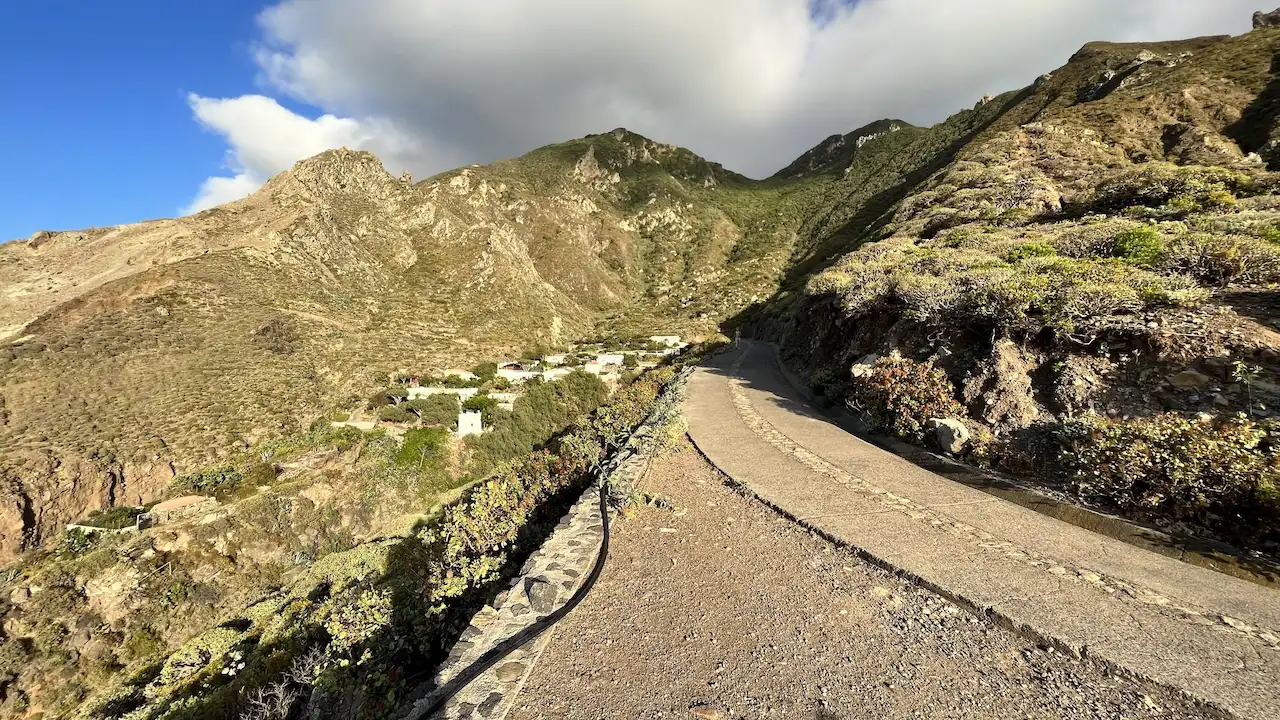
The TF-6.2 variant is, relatively, rather underwhelming as it goes on a regular rural road. TF-6.2 should be taken on your return when you are already low on energy.
The TF-6.3 variant has a few nice bits in it. Three stand out the most.
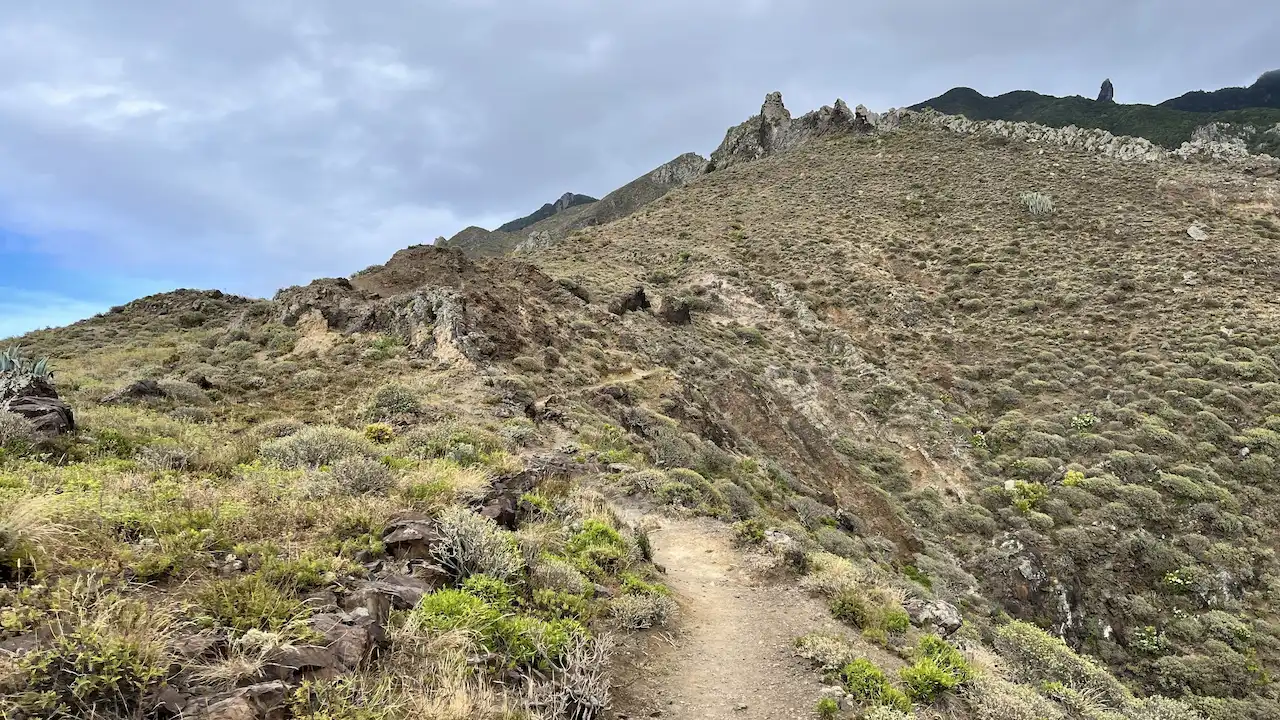
The ascent from the Benijo village is rather nice, though a bit steep. I hiked it with my 9yo son, but most parents would find this trail section not suited to kids under 12 or even 14, as there are some steeper and sketchy bits.
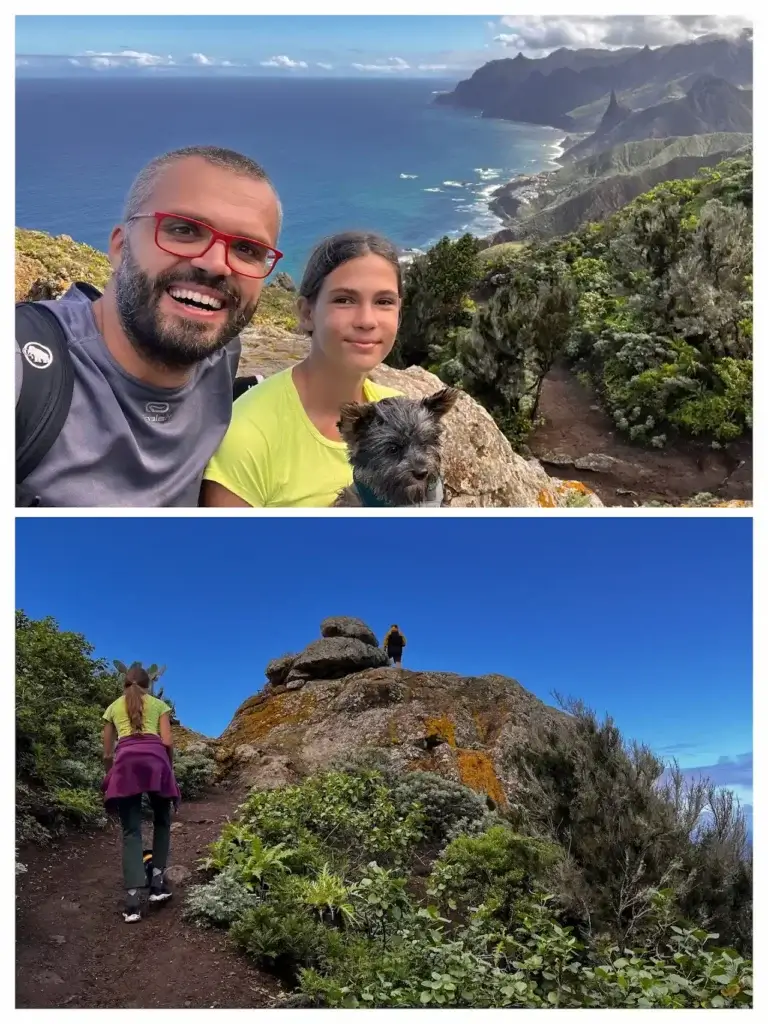
Then there is this rather nice rock in the picture. I haven’t been able to find its name, but it is quite a sight and makes for the ultimate TF-6 trail selfie background.
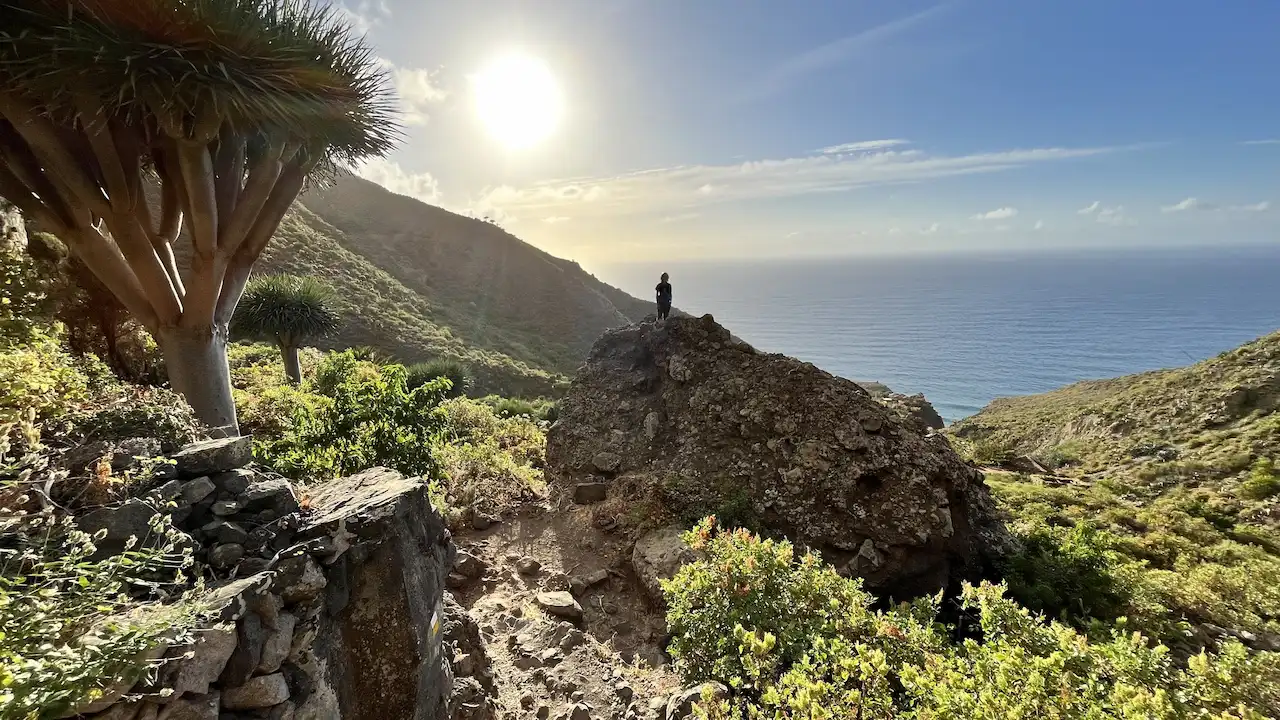
As you reach the highest point of the TF-6.3 variant, you join the TF-6 trail mid-way between the El Draguillo village and Cruz del Draguillo. This spot has a rather nice panorama of the village below and the ocean until the horizon, enclosed on both sides by a “picture frame” of Anaga mountains.
Unofficial variant

If you are considering to take the TF-6.1 variant, we would suggest you consider the trail in the map above. The original TF-6.1 between Chamorga and Faro de Anaga is marked with a red dotted line, and the suggested trail is marked in green. This way you both get the best bit of the TF-6.1 trail, but also a very scenic section between Cruz del Draguillo and Casas de Tafada house ruins.
To take this variant, you would head out from Chamorga towards the El Draguillo village, but take a right turn upon reaching Cruz del Draguillo. There is a crossroads marker that also shows the pass to Roque Icoso.

First, you will pass the Roque Icoso peak. It appears much more dramatic in the picture above than it is in real life, and in any case you don’t have to go near the edge if you don’t want to.

This trail also leads you to Casas de Tafada house ruins.

You can rejoin the TF-6.1 trail at the ruins, but we suggest that you first walk to the very gently inclined Montana de Tafada peak for an epic panorama of the Anaga Lighthouse and the ocean walk section of the TF-6.
Subjectively, this variant is at least 3-5 times as scenic as the TF-6.1 trail.
How to Get to the Trail Head in Chamorga
By Car
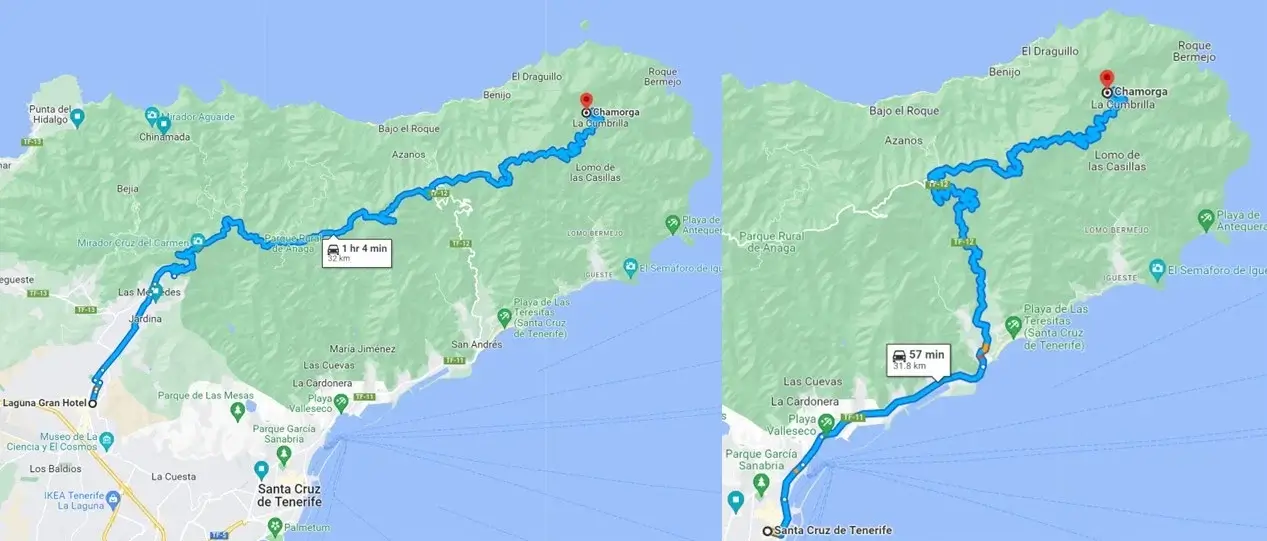
To get to the trail head in Chamorga by car, you’ll need to drive from the capital Santa Cruz de Tenerife on the TF-11 road or the historical town of La Laguna on the TF-12 road (whichever road is closer to your departure location).
The road between La Laguna is much more scenic, as more of it goes through the Anaga Rural Park. However, this is not for the novice driver, nor anyone who easily gets car sick. The road from Santa Cruz, past the Las Teresitas Beach is relatively calmer and less winding (but not too much).
While both routes are only 20-25 miles / 32-35 kilometers long, they really do require at least 1 hour for an experienced driver. If it’s your first time driving on mountain roads, easily plan 1,5 hours to get to Chamorga or Benijo villages.
All major car navigation apps – Google Maps, Apple Maps, and Waze – work well in Anaga, but always exercise caution, especially, if you go off paved roads.
We liked to use navigation apps when driving in Anaga, as they allowed to prepare for particularly sharp turns.
Also watch out for the usual “road idiots”. While locals are extremely polite and will wait for a safe stretch of road to overtake you, the same cannot be said about tourists. This particularly applies to motorcyclists who’ve rented powerful bikes and often use Anaga roads as a racetrack of sorts without regard for their own safety or that of others, as you can see in the video above.
By Bus
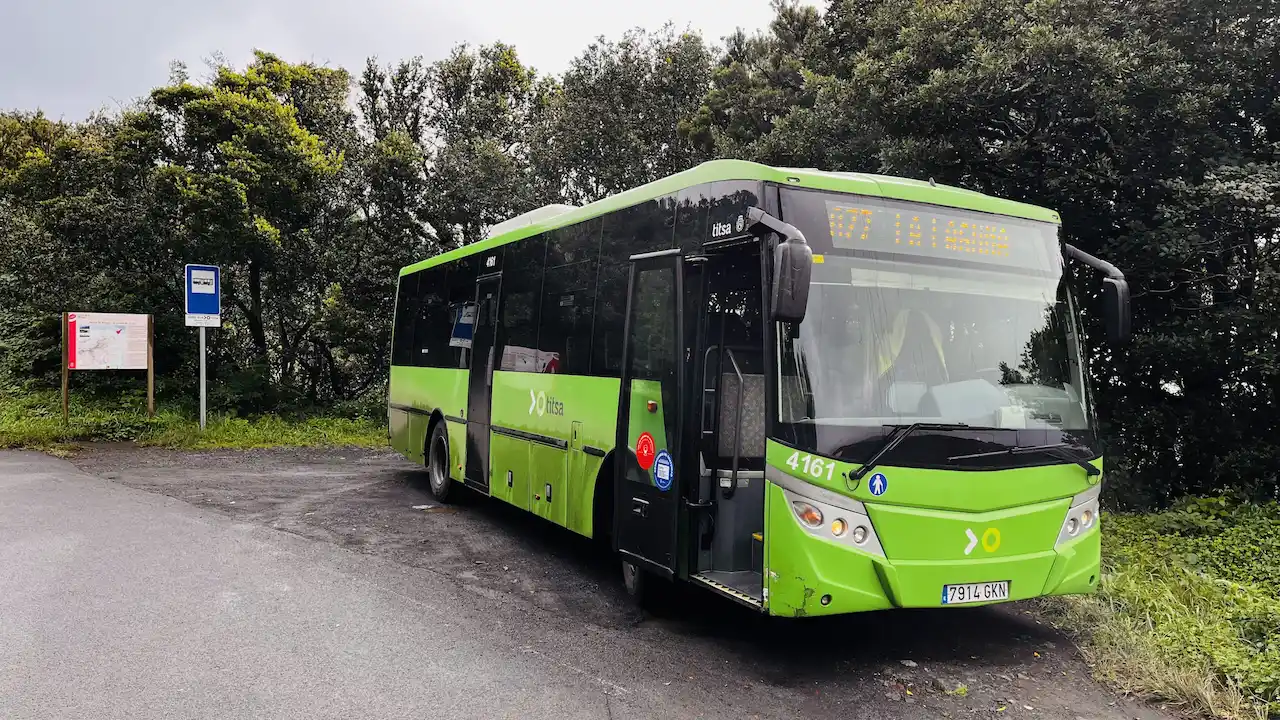
Public transportation by bus (called “guagua” on the island) is an option to get to and from Chamorga. While using a bus to get to the TF-6 trailhead or elsewhere is the more sustainable option, it does require some flexibility and planning, as the schedules are often limited to remote locations, particularly, in Anaga.
You will take bus 947 from the Santa Cruz Intercambiador or bus terminal.
The ride will take approximatelly 1 hour and 30 minutes. I must warn those who easily get car sick – don’t take this bus. My son and I never get car sick, but the last 10 minutes of our bus ride really put us on the verge of almost having to ask the driver to exit and walk the last stretch of road by foot.
There are only 3 buses per day on working days, and 4 during weekends and festive days.
WORKING DAYS
| FROM SANTA CRUZ | FROM CHAMORGA* |
| 05:10 | 06:20 |
| 15:00 | 16:30 |
| 18:00 | 19:25 |
WEEKENDS AND FESTIVE DAYS
| SANTA CRUZ | CHAMORGA |
| 07:00 | 08:20 |
| 10:15 | 11:45 |
| 15:00 | 16:30 |
| 18:25 | 19:55 |
Check the Titsa website for the current bus 947 running schedules between Santa Cruz and Chamorga.
The ticket price was around 2 euros.
From our experience, you can trust public transport connections and schedules on Google Maps. If a bust does not arrive on time, it is most often just delayed.
Hiking with a Guide
For those who prefer a guided excursion, there are local companies offering guided hikes on the TF-6 trail and other trails in Anaga.
— Guided tours with GetYourGuide.com —
These organized tours provide certified and knowledgeable guides who can share the area’s history, flora, and fauna while ensuring the group stays on the right path. Additionally, they often offer transportation directly from Santa Cruz de Tenerife or La Laguna. This eliminates the need to drive on the narrow roads yourself.
Guides can also be found through the Tenerife Hiking Community Facebook group. Hiking with a guide can be a great option for those looking for a more structured and informative experience on the trail. All guides through Get Your Guide and most certified guides found through other channels will provide insurance for participants during the hike.
How to Make Sense of Anaga Trails? Which to choose?
There are 12 official trails in the Anaga Rural Park in the North of Tenerife.
These trails are numbered from TF-1 to TF-12 and some have additional sections like TF-6.3 to add variety to your hikes or connect trails or villages with car parking locations and bus stops.
| Trail | Length (miles / km) | Vertical ascent (feet / m) | Difficulty | Additional Information |
|---|---|---|---|---|
| TF-1 | 2.36 / 3.8 | 1014 / 309 | Easy | Child-friendly |
| TF-2 | 7.46 / 12 | 1562 / 476 | Medium | Child-friendly |
| TF-3 | 6.03 / 9.7 | 2133 / 650 | Hard | Circular |
| TF-4 | 2.11 / 3.4 | 66 / 20 | Easy | Child-friendly, downhill trail |
| TF-5 | 6.84 / 11 | 1230 / 375 | Medium | |
| TF-6 | 7.89 / 12.7 | 3044 / 928 | Hard | Circular, top choice |
| TF-7 | 4.77 / 7.68 | 1089 / 332 | Easy | Child-friendly |
| TF-8 | 9.63 / 15.5 | 3353 / 1022 | Hard | Circular, top choice |
| TF-9 | 3.85 / 6.20 | 667 / 203 | Medium | |
| TF-10 | 7.41 / 11.91 | 853 / 260 | Hard | |
| TF-11 | 7.71 / 12.40 | 1292 / 394 | Hard | Top choice |
| TF-12 | 7.12 / 11.45 | 331 / 101 | Easy | Child-friendly, boring |
In all cases, I took the trail from the middle of Anaga Rural Park to the ocean side. The vertical ascent shown in the table is in the direction of the ocean. If you would take any of the trails in the opposite direction, they would be much harder.
The internet is full of Anaga trail suggestions that present a segment of these 12 trails as a unique trail, confusing both novice and experienced hikers.
The table above provides a useful overview of the 12 trails. You should also read our Guide to All Official Routes in the Anaga Rural Park.
Packing List for Hiking in Anaga
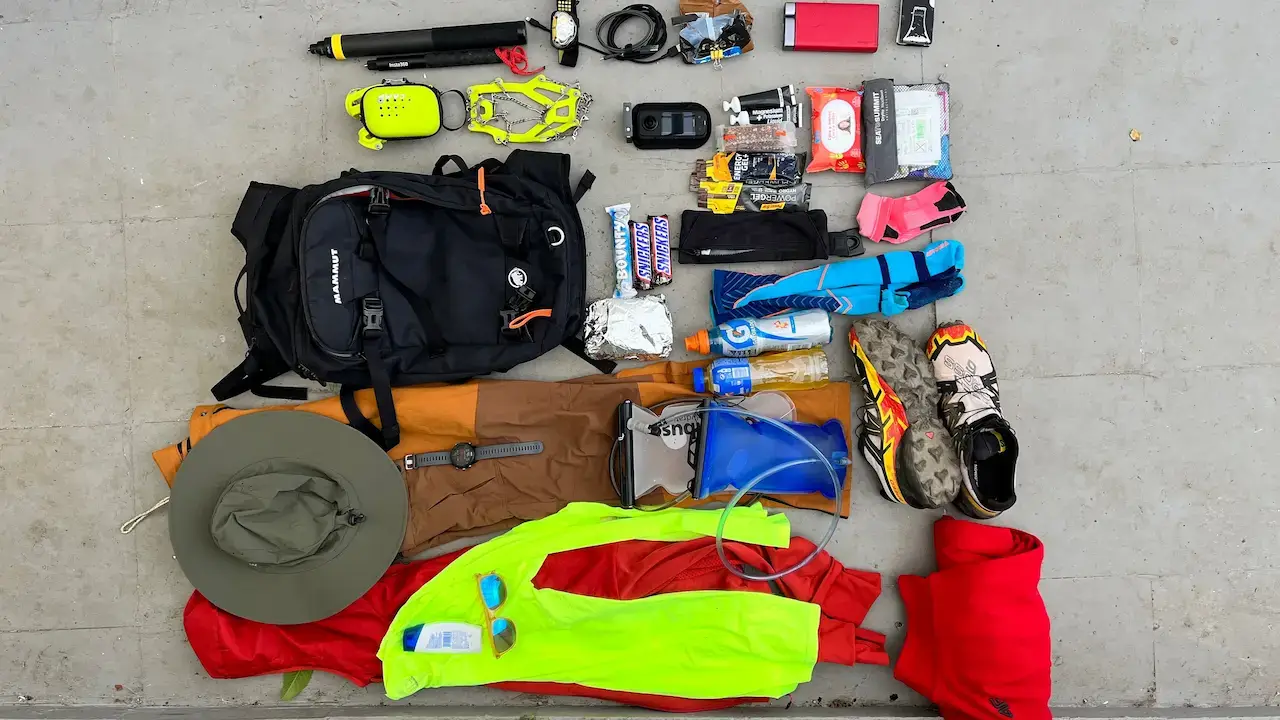
Food and Hydration
When preparing for a hike in the Anaga Rural Park, it is important to ensure you have enough water and food (in that order). Sufficient amount of water is particularly important during the hot season month of May-September as many of the best Anaga trails have large sections in open terrain without tree coverage.
Our suggestions for food items to bring along include:
- Sandwiches. Some towns and villages have restaurants and small cafes. However, there are trails that are less well served. Better to come prepared.
- Trail mix of nuts, dried fruits, and seeds to provide a quick energy boost.
- Bananas and other fresh fruits. Apples and oranges are also good choices as they stand up to heat and don’t get easily bruised.
- Energy bars and energy gels with sodium. Need for these will depend on your physiology and length of the hike, however, I would suggest to take along at least a few energy bars or sodium (and caffeine) gels in this trail to compensate sweat loss, avoid leg cramps and give an extra energy boost. If you haven’t hiked steeper hills in very hot climate before, be ready for significantly higher energy and fluid loss. You can stock up on these in the La Laguna Decathlon.
For hydration, it is vital to carry enough water or other liquids to last the duration of the hike. It is best to assume that there are no water sources en route (very few trails have a cafe on them, and even fewer have a pottable water fountain). A general guideline is to bring 0.5 to 1 liter of water per hour of hiking, depending on personal needs. I personally took 2-3 liters per hike and generally consumed it all by the end of a trail. It might be more during summer months, and less if you’ll hike in the November-March period or are a smaller person.
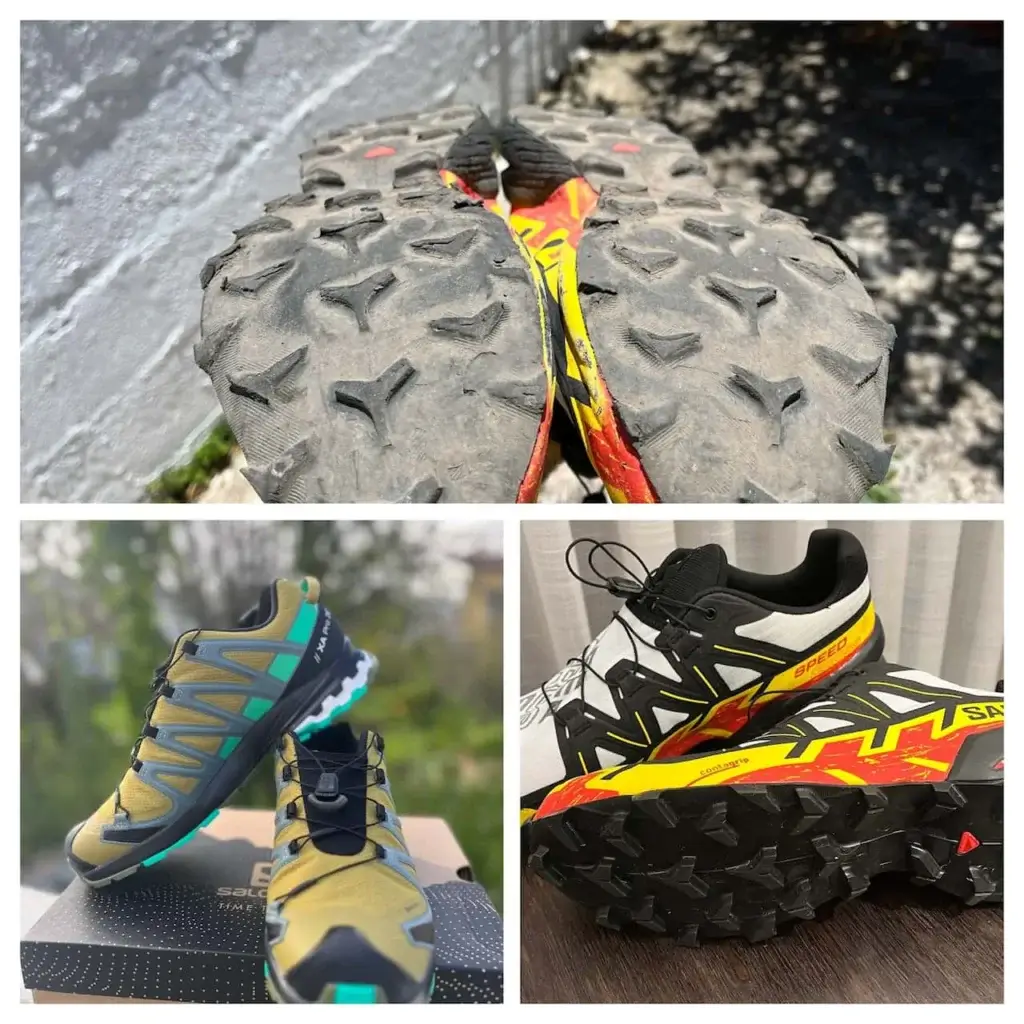
Equipment
While the necessary gear for hiking largely depends on individual preferences, we’d classify the following as necessary items on hikes in the Anaga Rural Park (in priority order):
- Comfortable hiking shoes and hiking socks. Hiking boots are not necessary, but definitely get hiking shoes with a good protector and toe protection. Hiking boots might be particularly uncomfortable during the hot season from May to September. We’re quite fond of the Salomon, Merrel, and Hoka trail shoes.
- Water flask or “camelback”. If you use a water flask, carry with you a sufficient amount of water for refills.
- Hiking backpack. A lightweight one-day backpack with comfortable straps will allow you to carry all necessary items during the hike.
- Sun protection. Bring sunscreen, sunglasses, and a hat to shield you from the sun during the hike.
- Power bank to charge your phone, as most people take a lot of pictures and videos when hiking in Anaga. You also should have your phone charged in case you need to call for help, although phone coverage can be spotty on this trail.
- First aid kit. A basic kit with band-aids, pain relievers, and any necessary personal medications can help with minor injuries or illnesses.
- Rain gear (necessary only in the December-February period).
Optional gear:
- GPS watch or a GPS device. This will save your phone battery even if you’re not a ‘quantified self’ zealot.
- Walking sticks, if you are used to them or your sense of balance is not that good.
Markings
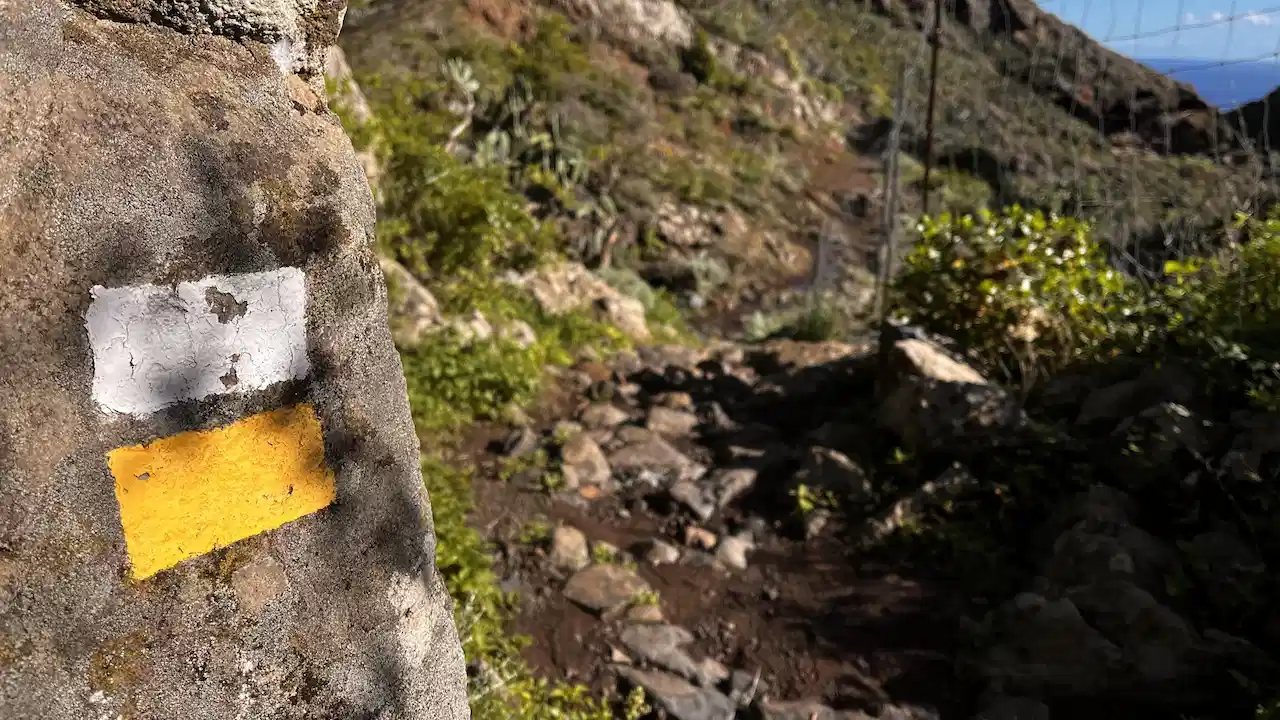
The TF-6 is well-marked with the typical white-and-yellow flag signs painted on rocks and other objects in places where there’s a chance you might choose the wrong direction. While other Anaga trails have spots where navigation is confusing without a GPS app, the TF-6 and its variants can be easily navigated without a mobile phone app.
That being said, I personally like to use GPS navigation apps. My favorites were Maps.me and Wikiloc, but others like AllTrails and Komoot are also widely used.
Be sure to download the necessary maps and routes before starting your hike. While there is phone reception on at least half of the route, data connection is almost nonexistent outside Chamorga and Benijo villages.
Facilities on the Trail (Cafes, WCs)
- Casa Alvares cafe in Chamorga. The cafe has a WC.
The only other eateries are past Benijo village in Almaciga and around Playa del Roque de las Bodegas, as these are already quite touristy areas. So come prepared.
Safety
General Tips
Summer: During the summer months, we recommend bringing plenty of water, sunscreen, and wearing appropriate headgear and clothing to protect against the sun. The heat can be very intense, so it’s essential to shield yourself, stay hydrated and take breaks when needed.
Rainy Season: In the rainy season, the trails can become slippery and more prone to landslides. Wear shoes with good traction, bring a rain jacket or a rain poncho, and be prepared for sudden changes in weather conditions. Remember that the temperature on average decreases by 1.8 degrees F / 1 degree C for every 100 vertical yards / vertical meters. If the temperature is still pleasant at ocean level in Santa Cruz, it can be quite cold when arriving in Chamorga and ascending.
Closed Section of the Trail
The TF-6 has an officially closed section between Faro de Anaga and El Draguillo. However, most people hike this section without issues.
Definitively avoid this section during and after rainfall and heavy rain. Inquire with the Tenerife Hiking Community on Facebook before your hike.
Do You Need a Permit to Hike the TF-6?
No permit is required to hike the TF-6 trail.
Only Sendero el Pijaral (former TF-7 trail) requires a free permit in the Anaga Rural Park.
Do You Need a Guide to Hike the TF-6?
Hiring a guide to hike the TF-6 trail is not required, as the trail is well-marked and relatively easy to follow. However, if you’re unfamiliar with the area or prefer having someone knowledgeable about the terrain and flora/fauna, hiring a guide can be a helpful option.
Dangerous Animals and Plants
Tenerife has no dangerous fauna, and very few somewhat dangerous plants that can cause skin and eye irritation. These are not an issue on the TF-6 trail.
If you hear something rustling in the grass, it’s just a family of lizards, as there are no snakes on the island (thank god!).
Can You Hike the TF-6 with Children?
The TF-6 trail is not the best for children, particularly, in the hot season.
Critically evaluate your child’s fitness and ability to withstand heat.
If you want to hike this trail with children 10 years and older, choose the TF-6.2 and TF-6.3 circle described above unless your child is an experienced hiker.
Mouflon Hunting
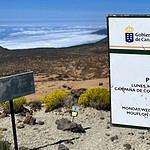
Mouflon hunting may rarely take place in the Anaga Rural Park. If it’s planned or ongoing, there will be signs at the trailhead and at regular intervals. Choose another trail if mouflon hunting is ongoing.
Forest Fire Warnings
Forest fires can be a risk in the Anaga Rural Park, especially during the hot season. There are years when the trails are closed for days or weeks due to forest fires or their risk.
Local in Chamorga will be aware of the current situation, and there will be signs at the trail head if you have missed the warnings in news.
Weather in Anaga Rural Park in Each Season
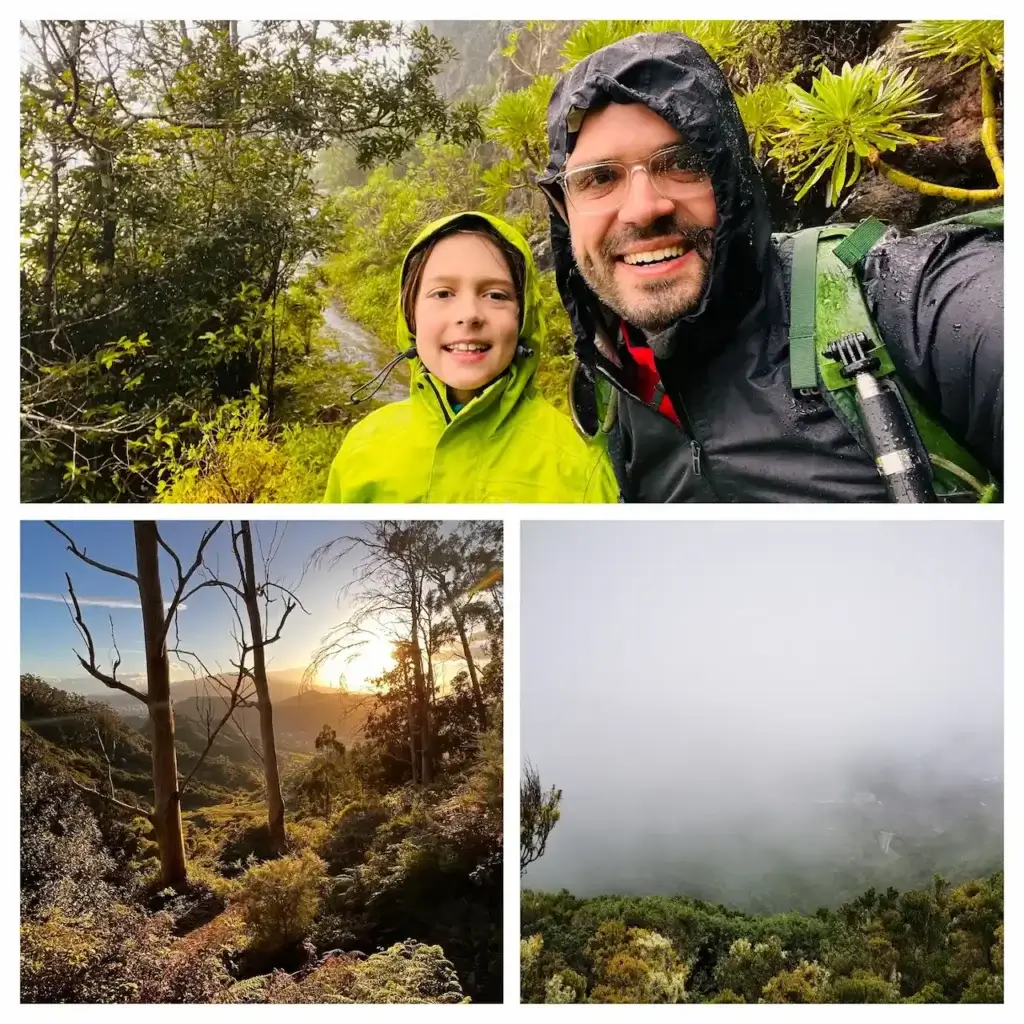
In Anaga Rural Park, the weather varies throughout the year, offering different experiences for hikers in each season.
Spring is a beautiful time to visit the park, as the temperatures are mild, ranging from 15°C to 20°C (59°F to 68°F). The chance of rain is moderate, but the lush green landscapes create nice views along the trail. As the laurel forests come to life, you’ll experience best what Anaga is famous for.
Summer in Anaga Rural Park tends to be very hot and dry, with temperatures going over 30 °C (86°F). The heat can make hiking challenging, so it’s vital to stay hydrated and protected from the sun as most of the trail goes in open terrain.
The calima, a hot and sandy wind from the Sahara desert, may occasionally affect the park, reducing visibility and increasing temperatures. Calima negatively affects people with asthma and other respiratory issues. Public authorities regularly warn of calima.
The Autumn season brings cooler temperatures, ranging from 20°C to 30°C (68°F to 86°F), while rain is still uncommon until November and December. Mild showers are possible, but most often these are a welcome respite.
Winter from December to mid-March sees temperatures ranging from 10°C to 18°C (50°F to 64°F). There can be a very high chance of rain, so come prepared with proper clothing, waterproof gear, and footwear. Despite the cooler weather, winter can be an excellent opportunity for hiking the TF-6 trail, as you’ll find fewer crowds and a serene atmosphere.
Anaga Rural Park Rules
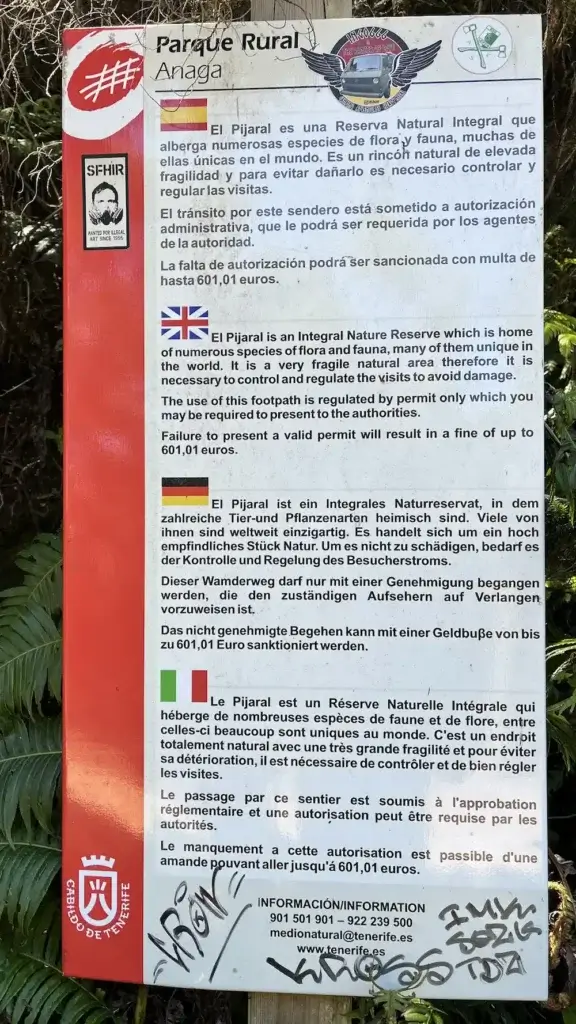
Lighting a Fire
Lighting a fire is strictly prohibited, even gas stoves.
Wild Camping
Wild camping is officially not permitted.
I’ve asked park rangers about wild camping, and the unofficial policy appears to be that as long as you clean up after yourself and leave a location as you found it, you should not run into trouble. Camping should be done only in groups of 1-2 persons.
Collecting Flora and Rocks
Preserving Anaga Rural Park’s unique biodiversity is crucial. Therefore, it is striclty prohibited to collect flora (plants, flowers, fruits, etc.) or rocks from within the park.
Border guard and customs officials regularly check for plants on the border. For example, my wife’s plants purchased and collected on the island outside protected areas were anyway confiscated by customs officials when she arrived on Spanish mainland with a ferry.
Taking Trails Without a Permit
There areas in Anaga which are strictly of limits such as the Monte Aguirre area close to Cruz del Carmen.
The only trail requiring a free permit is the Sender El Pijaral trail. If you are caught on this trail without a permit, or in any of the prohibited nature reserve areas, the fine can go up to 601.01 euros.
Where to Stay in Anaga (Recommended Hotels and Homestays)
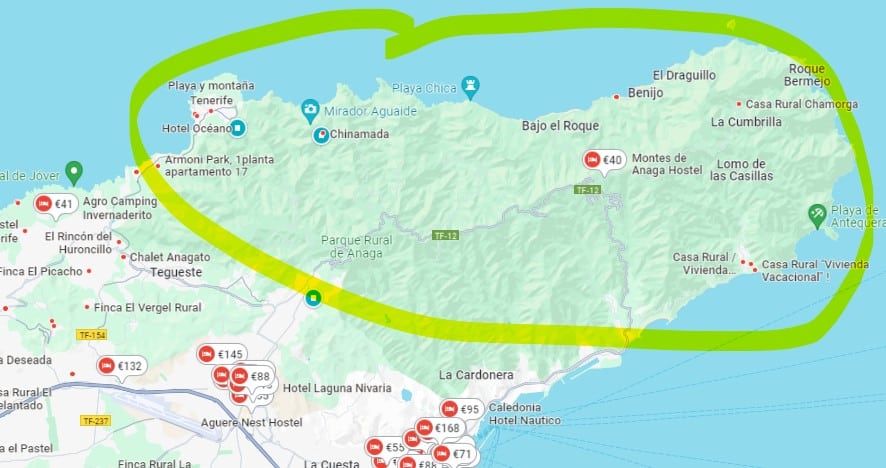
There are not very many options of staying overnight in the Anaga Rural Park itself and these are concentrated in the largest villages like Taganana, Almaciga and Benijo. I’ll add recommended options for hikers at a later date. In the meantime, search Booking.com for Anaga, read the reviews and check the accommodation’s proximity to hiking trails.
Useful Resources for Hiking in Anaga Rural Park
Tenerife Hiking Community on Facebook
We recommend joining the Tenerife Hiking Community on Facebook to connect with fellow hikers and gather useful information before embarking on your hike in Parque Rural de Anaga. This online community shares helpful tips, experiences, and suggestions from those who’ve previously explored the various trails in Tenerife and other Canary Islands.
Cruz del Carmen Tourist Information Centre
We found it very useful to visit the offical Anaga Rural Park Information Centre (Centro de Visitantes del Parque Rural de Anaga) at Cruz del Carmen close to the park border when driving from La Laguna.
The centre has English-speaking and very competent staff. You can also obtain a printed leaflet for each of the Anaga trails there (if they haven’t run out of these), as well as an excellent material about all trails on one sheet.
Visiting the centre is an excellent way to make a last check whether the information you have gathered online corresponds to reality on the ground in Tenerife.
Address: Barrio Cruz Carmen, 2, La Laguna, Santa Cruz de Tenerife, Spain (Google Maps location)
Working hours: every day from 9:30 AM to 3:00 PM.
Cruz del Carmen is the starting location of the child-friendly Path of the Senses (Sendero de los Sentidos), end-point of the TF-1 trail that comes up from the Las Mercedes village, as well as the more serious TF-10, TF-11, and TF-12 trails.
Hiking Gear Shops
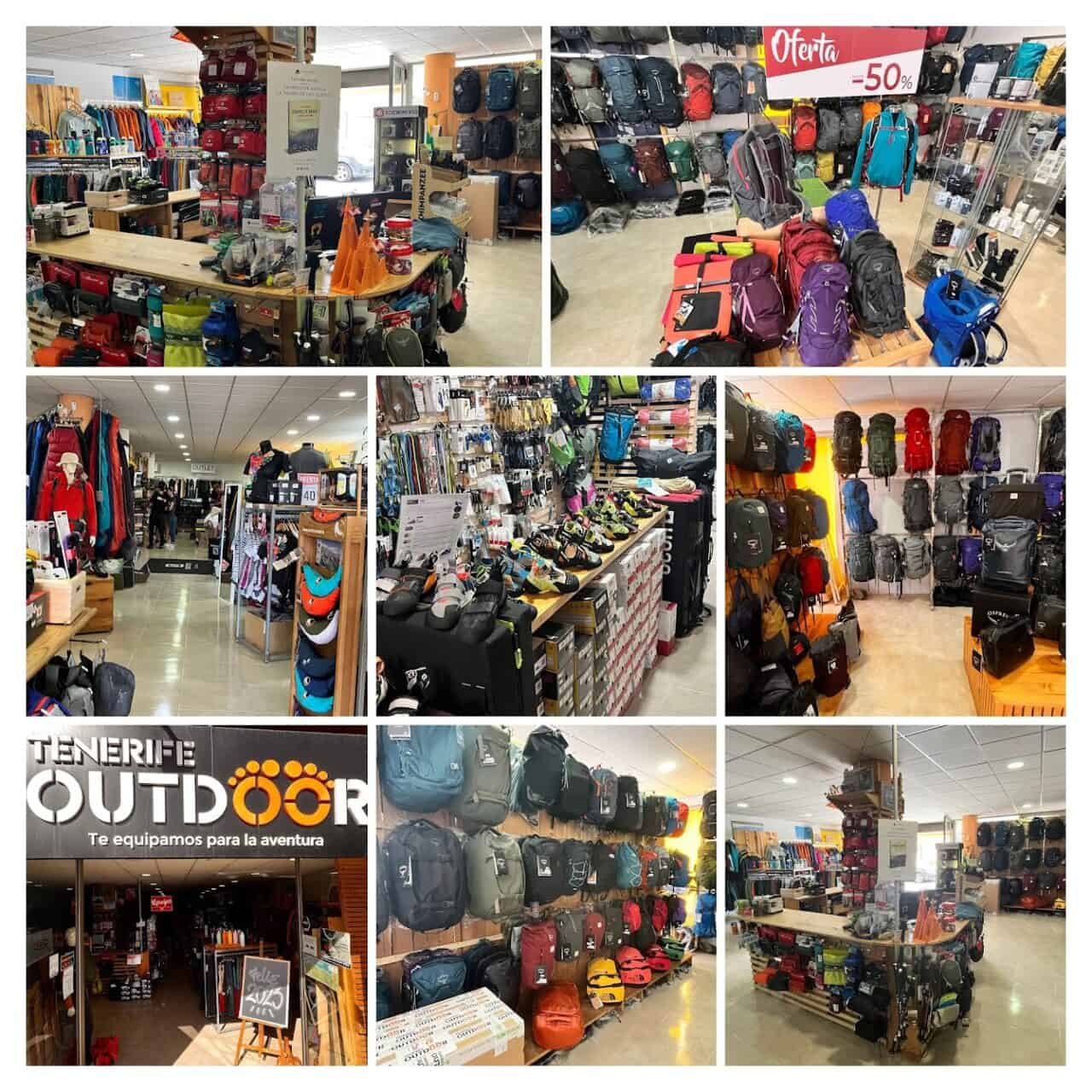
If you are missing some hiking or running equipment or are looking for a possible impulse buy, we recommend you stop by at the Tenerife Outdoor La Laguna store. This is the best hiking and camping gear shop in the North of the island, period. Below are two other recommendations you can also check out before you head out to the Anaga Rural Park.
- Tenerife Outdoor La Laguna, Av. de la República Argentina, 79, Local Bajo, 38208 La Laguna, Google Maps link. A wide selection of top brands of outdoor goods. You can also rent hiking and camping gear like walking sticks for 8 euros a day here.
- base: Deportes Salud, TF-13, 153, 38280 Tegueste, Google Maps link. The small store is more focused on regular sports, but has a decent selection of hiking shoes and walking sticks. Stop by for some good deals during sales periods. We managed to get great Salomon hiking shoes at a 50% discount.
- Decathlon La Laguna, Cam. la Hornera, 160, 38205 La Laguna, Google Maps link
— Guided tours with GetYourGuide.com —
Frequently Asked Questions
No. Just wear appropriate footwear with good grip and shield yourself from the sun (and rain in winter months). Do not hike during of after strong rain and during heavy wind, as this increases the risk of falling rocks and landslides.
The best time to hike the TF-6 trail is during the spring and autumn months, when the weather is mild and pleasant. However, the trail can be hiked all year round.
A guide is not required to hike the TF-6 trail, as the trail is well-marked and easy to follow. However, if you’re inexperienced or would like a more in-depth understanding of the area and its surroundings, a guided hike might be a good option.
While the TF-6 trail is considered as physically hard, inexperienced hikers can still complete it if they are in a reasonable physical condition, and carry with them enough water and food.
While public transport is available in Tenerife, renting a car is a more convenient option when visiting the Anaga Rural Park. It allows you to enjoy the flexibility and freedom to explore the park at your own pace without stressing about ‘Gua Gua’ schedules. That being said, the winding roads of the Anaga Massif can be challenging for some drivers, so assess your driving skills realistically.
Yes. All Anaga Rural Park trails are dog-friendly. There are no snakes or other dangerous animals on Tenerife, so your dog can roam around quite freely. The only things you would have to watch out are the occasional dog of another hiker, and trails with steep slopes where your dog might slide or even fall off.

